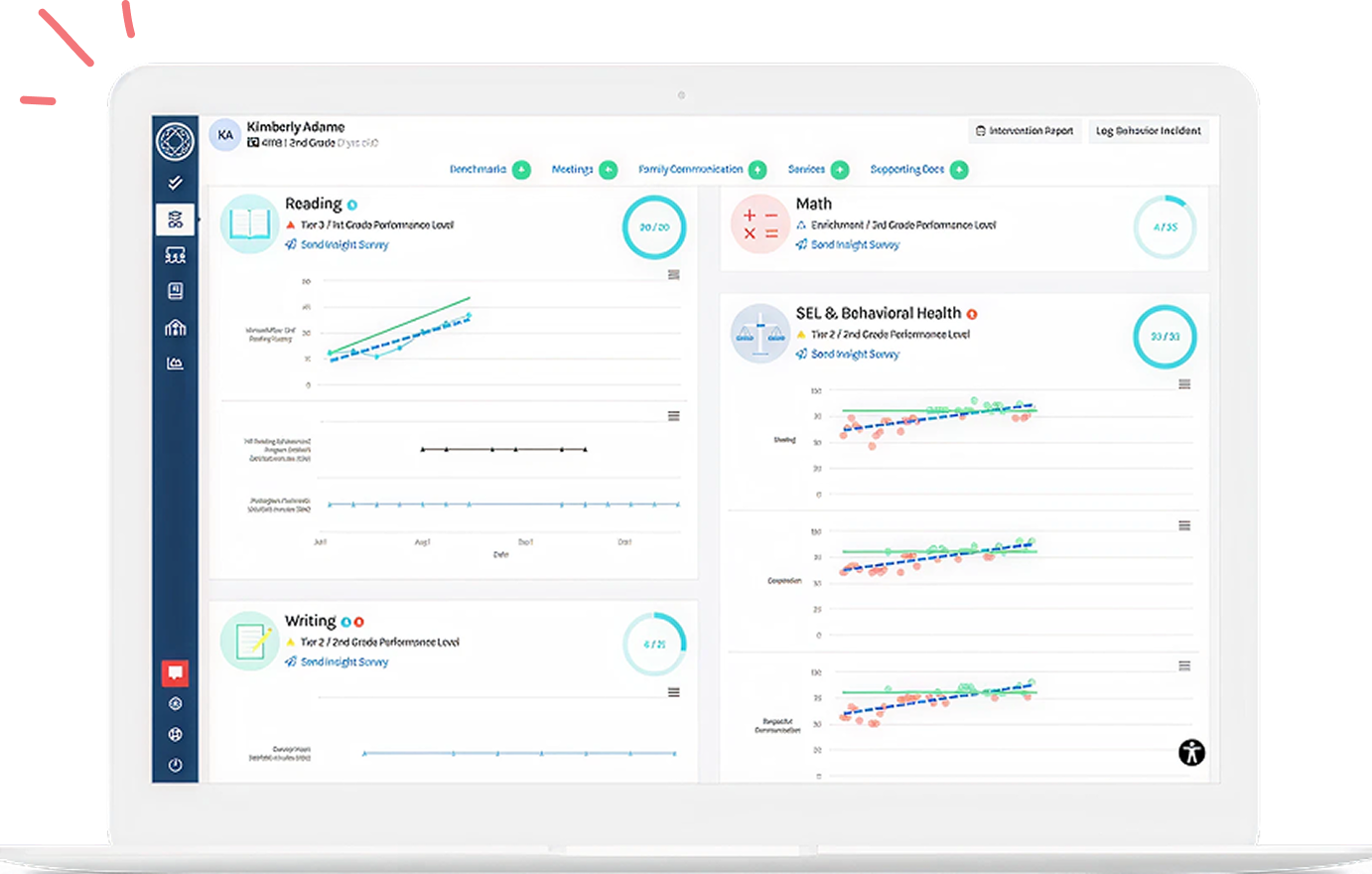It’s your job to pull all the pieces together—and WOW are there a lot of pieces! From curriculum planning and enrollment management, to staffing and addressing the diverse needs of students and teachers, to connecting with the community and advocating for your campus. Underneath it all is a well of data that can inform your next steps. Using data effectively is a crucial leadership skill. Academic assessments, intervention monitoring, attendance and behavioral data help you make informed decisions that drive school improvement and boost student success …. IF you know what to look at, how, and when.
Turning Data Into Action
To kickstart your year effectively, here are some best practices and essential questions:
|
The Tier Automation feature in Branching Minds makes it easy to analyze tiering needs for students based on EOY assessment results. You can then review the effectiveness of your intervention (and core instruction!) from the Tier Movement Report. Teachers can refine their Tier 1 instructional strategies for the current class, ensuring they are well-prepared before the first universal screener of the year. Tier Movement Report
|
Reflection and Performance Insights
You are diving headlong into a new school year, but some of the most valuable data you can spend time with right now is last year’s EOY data! A look in that rear-view mirror can guide your decision-making, ensuring alignment with the school’s vision, facilitating targeted improvements, sharpening your strategic focus, and enhancing accountability for the year ahead.
💡Key questions to consider:
→ What insights did we gain from last year’s performance data, and how will
these insights shape our strategies for this year?
→ What are our primary instructional goals and priorities for this year, and how do they align with the school’s overall vision?
The tiering system from the Universal Screeners has been invaluable. We are able to just in a click of a button have an entire tiered system of the kids that we need to be really looking at on a tiered level. It's taking the cognitive load off of us to do the data work.
- Jenn Maichin, High School Principal, NY
Set Up and Measurement of MTSS Practice
A Multi-Tiered System of Supports (MTSS) is most effective when approached as a practice of continuous improvement. Regular monitoring of implementation helps you set clear, measurable goals, track progress through relevant metrics, and promote staff collaboration.
💡Key questions to consider:
→ What are our goals for MTSS implementation, and how will we measure success?
→ What metrics and data points will we use to track progress and inform decision-making?
→ How will we support staff in collaborating and sharing best practices?
Tips for Success:
To promote collaboration and regular sharing of best practices among staff to make MTSS a school-wide effort, consider these strategies:
- Schedule collaboration time for staff to meet, review MTSS data, and plan strategies and interventions together.
- Offer ongoing professional development, workshops, and digital resources focused on MTSS. Encourage staff to engage in and share findings from MTSS-related research.
- Recognize and showcase effective MTSS practices and their impact.
- Facilitate peer observations or feedback on MTSS practices to understand learnings and scope for improvements.
- Pair experienced staff with newcomers for support and guidance.
|
Implementation Health Report |
Core Instruction and Differentiation
Another key step is to evaluate the quality of core instruction and ensure it is differentiated to support diverse learners. Addressing these questions helps evaluate and improve Tier 1 supports, choose the right assessment tools, and identify necessary professional development to enhance instructional quality:
💡Key questions to consider:
→ Are our Tier 1 supports effectively meeting the needs of all students?
→ Which assessment tools and strategies will we use to evaluate student learning and progress effectively?
→ What professional development is needed to enhance Tier 1 instruction and support?
|
“Something that we really use a lot is the Branching Minds' Tier Level Report — you can look at a classroom level, grade level, building level. We've pulled up the data on the reading scores and see where the growth, gaps, or inconsistencies are. We find that we can be so much more responsive to data than we were able to before.” - Jen Bognar, Director of Exceptional Learning, IN |
Tier Level Report
|
Student Assessment and Intervention
Two best practices include a regular screening processes for early identification of students requiring Tier 2 or Tier 3 interventions and clear protocols for record-keeping and monitoring.
💡Key questions to consider:
→ How will we screen and assess students to identify those who need additional support?
→ How will we address and manage student behavior to promote a positive and productive learning environment?
Educators love how Branching Minds provides an integrated behavioral screener, the Student Risk Screening Scale - Internalizing and Externalizing (SRSS-IE), that helps you proactively identify possible behavioral needs and take action to develop targeted behavior plans and group students with similar skill gaps for intervention.
|
Cohort Assessment Report
|
Sustainability
Finally, assess your MTSS implementation with an eye to sustainability.
💡Key questions to consider:
→How will we evaluate and refine our MTSS practices based on feedback and outcomes?→What is our plan for sustaining MTSS practices over the long term?
Closing
“We want to make sure that student is achieving their success. The intervention, collecting that data, looking at the growth or if a student is not making that growth, being able to look at all the data, piece it all together, and looking at letters that have been sent home that we've included in the student's file, looking at the graphs, looking at the parent communication, that all plays a role in supporting that student.” -- Bob Biedke, Principal, Ilinois
Can you see all those puzzle pieces coming together and forming a complete picture? Data alone isn’t enough, you need to know when and how to gather insight from the data and then take action.
About the author
Branching Minds
Branching Minds is a highly respected K-12 services and technology company that leverages the learning sciences and technology to help districts effectively personalize learning through enhancements to their MTSS/RTI practice. Having worked with hundreds of districts across the country, we bring deep expertise in learning sciences, data management and analysis, software design, coaching, and collaboration. Combined with our extensive toolkit of resources, PD, and technology, we provide a system-level solution. We are more than a service or a software provider, we are partners who will deliver sustainable results for educators, and a path to success for every learner.

Your MTSS Transformation Starts Here
Enhance your MTSS process. Book a Branching Minds demo today.













.png?width=1436&height=956&name=How%20Leaders%20Use%20MTSS%20Data%20to%20Drive%20School%20Improvement%20(2).png)



.png?width=383&height=255&name=Untitled%20design%20(6).png)



.png?width=716&height=522&name=Tier%203%20Behavior%20Support%20Planning%20(preview).png)
